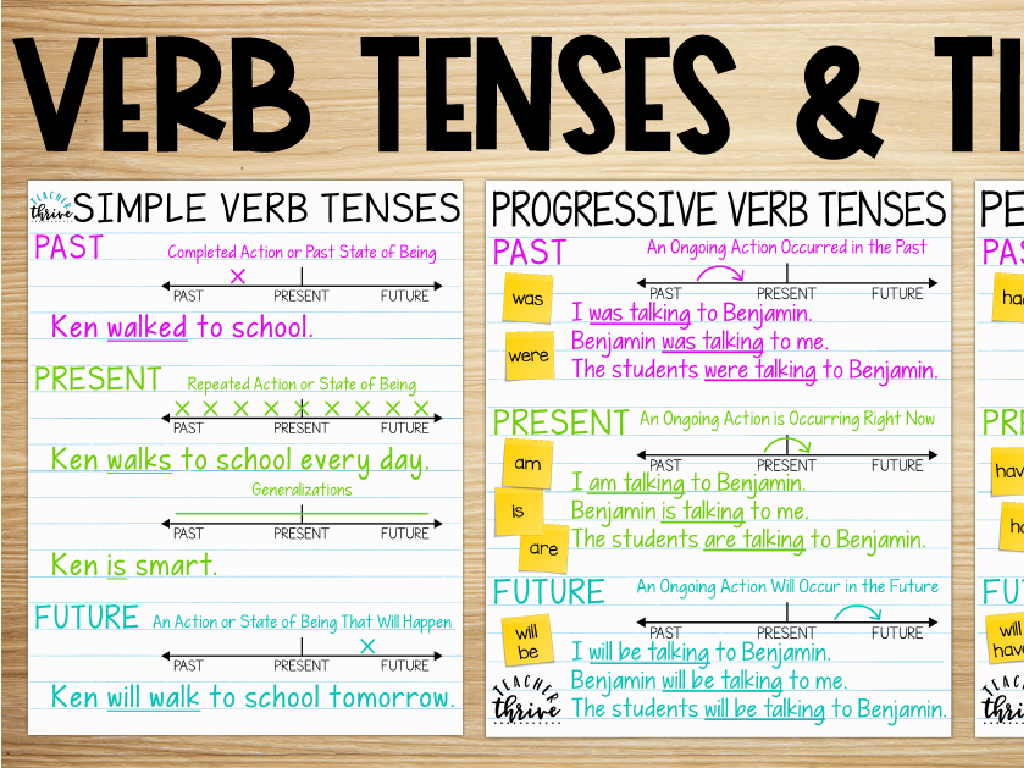Subtract Decimal Numbers
Subject: Math
Grade: Fifth grade
Topic: Add And Subtract Decimals
Please LOG IN to download the presentation. Access is available to registered users only.
View More Content
Introduction to Decimals
– Recap: What are decimals?
– Decimals represent fractions of a whole, like money: $0.75
– Decimals in daily life
– Seen in money, measurements, and time
– Understanding decimal place values
– Each place after the decimal represents a tenths, hundredths, etc.
– Review: Adding decimals
|
Begin the lesson by recapping the concept of decimals, emphasizing their representation of parts of a whole, which is a foundational concept in understanding decimals. Relate decimals to everyday life by using examples such as money, where decimals are used to represent cents, or measurements in cooking. Reinforce the concept of place value, which is crucial when performing operations with decimals. A quick review of adding decimals will set the stage for learning subtraction, ensuring that students are comfortable with decimal manipulation. Use visual aids like place value charts to help students visualize the position and value of each digit in a decimal number.
Subtracting Decimals: The Basics
– Decimals subtraction like whole numbers
– Align decimal points to subtract
– Just like stacking blocks, decimals above decimals!
– Example: 8.2 – 5.3
– 8.2 is like 8 dollars 20 cents, 5.3 is like 5 dollars 30 cents. How much left?
– Practice with different examples
– Try subtracting 15.75 – 7.6 or 10.5 – 3.28
|
Begin by explaining that subtracting decimals is very similar to subtracting whole numbers; the key difference is the presence of the decimal point. Emphasize the importance of aligning the decimal points, which is like making sure the ones, tens, and hundreds places are lined up in whole number subtraction. Use the example of 8.2 minus 5.3 to illustrate this concept, showing step by step how to align the decimals and subtract. Encourage students to practice with additional examples, and provide guidance on how to handle different decimal places, ensuring they understand the concept of ‘borrowing’ when necessary.
Subtracting Decimals with Regrouping
– Understanding regrouping
– Regrouping is borrowing from the next column.
– Example: 20.75 – 15.6 with regrouping
– We regroup when subtracting a larger digit from a smaller one.
– Practice problem: 30.5 – 12.4
– Try subtracting using regrouping, just like the example.
|
This slide introduces the concept of regrouping, which is necessary when a digit in the minuend is smaller than the corresponding digit in the subtrahend. Start by explaining regrouping, then walk through the example of subtracting 15.6 from 20.75, showing how to borrow from the next column to the left. After the example, provide a practice problem for the students to apply what they’ve learned. Ensure to explain that regrouping in decimals is similar to whole numbers, but we work with tenths, hundredths, etc. Encourage students to line up the decimal points before they begin subtracting. The practice problem should be solved in class, with students volunteering to show their work on the board.
Word Problems: Subtracting Decimals
– Identify decimal subtraction in problems
– Look for keywords like ‘left over’, ‘change’, ‘difference’
– Example: Real-life decimal subtraction
– If a pencil costs $1.15 and you pay with $2, how much change do you get?
– Tips for accurate subtraction
– Line up the decimals, subtract like whole numbers
– Checking your subtraction work
– Review your steps, ensure decimals are aligned
|
This slide aims to help students tackle word problems that involve subtracting decimals. Start by identifying key phrases in the problem that suggest subtraction. Use real-life scenarios, such as calculating change, to make the concept relatable. Provide tips for proper alignment of decimals and subtraction as if they were whole numbers. Emphasize the importance of double-checking work by revisiting each step and ensuring that the decimal points are correctly aligned throughout the problem. Encourage students to practice with various word problems to gain confidence in their subtraction skills.
Class Activity: Subtracting Decimals
– Engage in decimal subtraction activity
– Pair up to solve subtraction problems
– Present a problem and solution to class
– Explain your problem-solving steps
– Learn from peers’ presentations
– Listen and discuss different methods
|
This interactive class activity is designed to encourage collaboration and peer learning as students work in pairs to tackle decimal subtraction problems. Provide a set of subtraction problems involving decimals for each pair. Encourage students to discuss their problem-solving strategies with their partner and ensure they write down each step. After solving the problems, each pair will choose one problem to present to the class, explaining their method and the solution. As pairs present, the rest of the class should pay attention and be ready to discuss different approaches to subtraction. This activity will help students understand decimal subtraction concepts better and learn various techniques from their classmates. Possible activities for different pairs could include subtracting decimals in money transactions, measurements for a recipe, or distances in a race.
Review and Practice: Subtracting Decimals
– Recap key subtraction points
– Remember to line up the decimal points and subtract like whole numbers.
– Solve a class practice problem
– Let’s try 15.6 – 9.8 together on the board.
– Distribute practice worksheets
– Each worksheet has problems to help you practice more.
– Encourage independent practice
|
Begin the slide by quickly reviewing the main points of subtracting decimal numbers, emphasizing the alignment of decimal points. Then, engage the class with a practice problem on the board, encouraging participation to solve it collectively. Afterward, hand out worksheets with a variety of problems for additional practice. Remind students that practicing these worksheets will help reinforce their understanding of decimal subtraction. Offer support and encourage students to attempt the problems independently, fostering confidence in their skills.
Homework: Practice Decimal Subtraction
– Complete the decimal subtraction worksheet
– Worksheet has various problems to solve
– Attempt one problem before leaving
– Try at least one to get started
– Bring questions to the next class
– Don’t hesitate to ask for help!
– Practice makes perfect!
|
This slide outlines the homework assignment for students, which involves completing a worksheet focused on subtracting decimal numbers. Encourage students to attempt at least one problem before they leave to ensure they understand the instructions. Remind them that practice is key to mastering decimal subtraction and to bring any questions or difficulties they encounter to the next class for clarification. This will help them feel prepared and supported. The worksheet should include a range of problems, from simple to more complex, to cater to different skill levels within the class.





